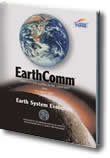This investigation will help you to:
- The Formation of the Earth and Moon
- Tides
- To find tidal data for several different cities, visit the following web sites:
- To learn more about why the Earth has two tidal bulges, visit the following web sites:
- To learn more about tidal forces throughout the solar system, visit the following web sites:
- To learn more about impact craters throughout the solar system, visit the following web sites:
- Age of the Earth, USGS
Find out a more about how scientists believe how and when the Earth formed. - Theories for the Formation of the Earth's Moon, Online Journey Through Astronomy
Learn about what restrictions any theories for the formation of the moon must account for, why some theories work, and why some do not work.
- Our Restless Tides, NOAA, CO-OPS
Get an explanation of the basic astronomical factors which produce tides and tidal currents. - Lunar Tides , Journey Through Astronomy
Look at the role that the moon plays in the tides. This site also looks at the role that the sun has when combined with or against the moons gravitational pull.
IMPORTANT: Please review the following information to help understand the tidal prediction data. Or try the following pages on the NOAA - Center for Operational Oceanographic Products and Service:
What formats are tide predictions available in?
Standard Format - This format is available in hard copy and an electronic, ASCII file which provides time and height of tide information for a single location in a page readable format. The following example for EASTPORT, ME, April, 1997 shows the predictions in AM/PM Time and has been adjusted for Daylight Savings Time.
Eastport, Maine T.M. 75 W.
Tide Predictions (High and Low Waters) April, 1997
NOAA, National Ocean Service
Standard Time
| Day | Time | Ht. | Time | Ht. | Time | Ht. | Time | Ht |
| 1 Tu | 428am | H 18.6 | 1101am | L 0.7 | 504pm | H 17.8 | 1128pm | L 1.5 |
| 2 W | 532am | H 18.8 | 1204pm | L 0.4 | 608pm | H 18.2 | ||
| 3 Th | 1233am | L 0.9 | 636am | H 19.2 | 107pm | L -0.2 | 711pm | H 19.0 |
| 4 F | 136am | L 0.0 | 739am | H 20.0 | 207pm | L -1.1 | 810pm | H 20.1 |
| 5 Sa | 235am | L -1.2 | 838am | H 20.9 | 304pm | L -1.9 | 906pm | H 21.1 |
Please Note: All heights are in feet.
How accurate are the predictions?
The accuracy of the tide predictions is different for each location. Periodically we do a comparison of the predicted tides vs the observed tides for a calendar year. The information generated is compiled in a Tide Prediction Accuracy Table. We work to insure that the predictions are as accurate as possible. However, we can only predict the astronomical tides, we cannot predict the effect that wind, rain, freshwater runoff, and other short-term meteorological events will have on the tides.
In general, predictions for stations along the outer coast are more accurate than those for stations farther inland; along a river, or in a bay or other estuary. Inland stations tend to have a stronger non-tidal influence; that is, they are more susceptible to the effects of wind and other meteorological effects than stations along the outer coast. An example of an inland station which is difficult to predict is Baltimore, Maryland. This station is located at the northern end of Chesapeake Bay. Winds which blow along the length of the bay have been known to cause water levels to be 1-2 feet above or below the predicted tides.
Stations in relatively shallow water, or with a small tidal range, are also highly susceptible to meteorological effects and thus difficult to accurately predict. At these stations, short-term weather events can completely mask the astronomical tides. Many of the stations along the western Gulf of Mexico fall into this category. An example is Galveston, Texas. This station is in a bay which is relatively shallow and has a small opening to the sea. At this station it is possible for meteorological events to delay or accelerate the arrival of the predicted tides by an hour or more.
- Tides Online, NOAA
Access current tide information. - Ocean in Motion: Tides - Characteristics, Office of Naval Research
Learn more about why the Earth has two tidal bulges instead of just one.
- Jupiter: Moons: Io, NASA
Compare the tides on Io to Earth. - Galileo Continues to Return Data from February's Flyby of Io, Jet Propulsion Laboratory
In July 10 - 16, 2000, the Galileo spacecraft flew by Io and sent back new information about its tides. - Saturn - Lord of the Rings, Tufts University
Why do planets have rings? Find out about the connection between rings and tidal forces.
- Finding Impact Craters, NASA
Get more information about impact craters on Earth and the moon. - Impact Craters on the Planets, Lunar and Planetary Institute
Check out images of impact craters on Mercury, Venus, the Moon, Jupiter's moon, Ganymede, Saturn's moon, Dione, and Uranus' moon, Miranda.

